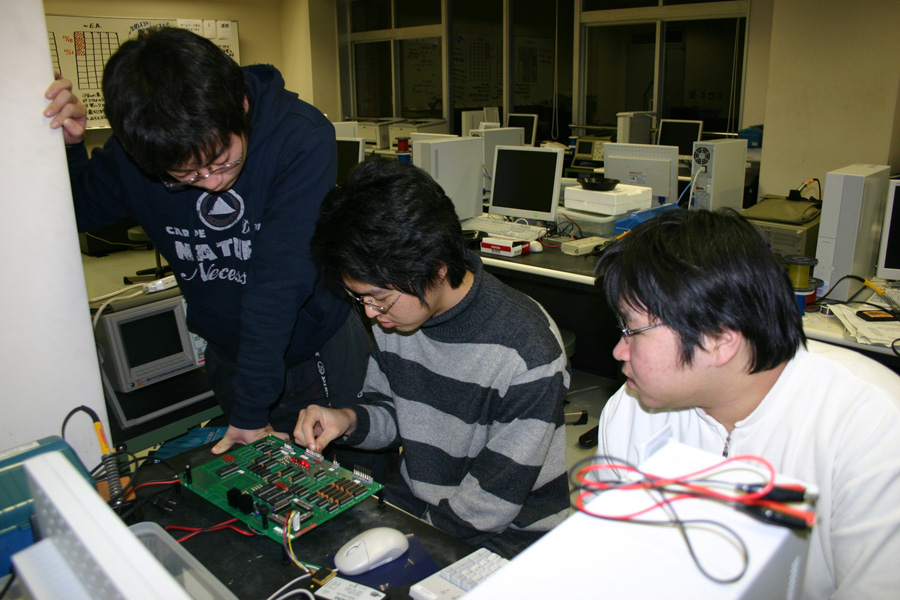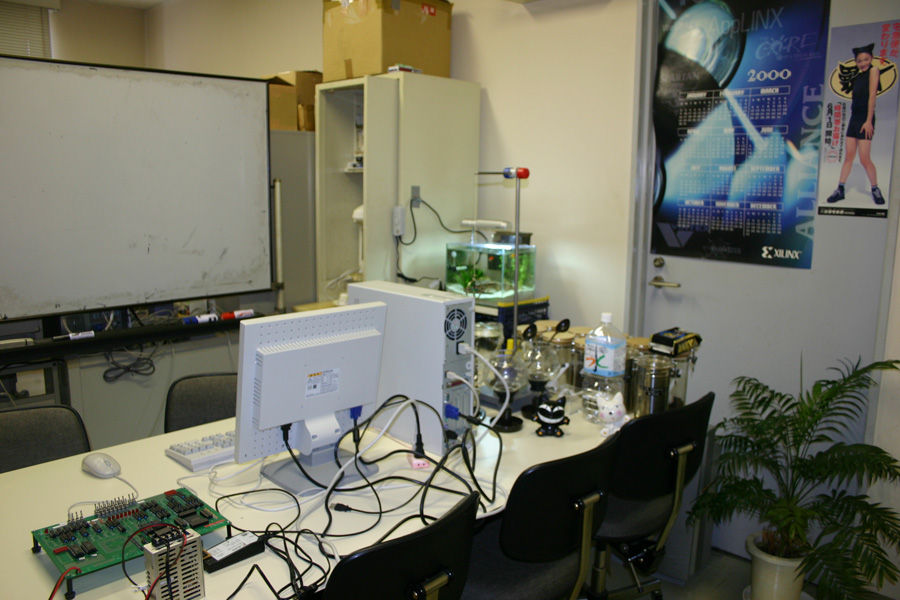Microcomputer Design Educational Environment City-1 on Verilog HDL and FPGA in 2006
for the junior students of the Department of Computer Engineering,
Faculty of Information Sciences, Hiroshima City University

|
A video God's will is introducing the last 5 years (2004-2008) of City-1, which is an educational course held successfully by Ryuichi TAKAHASHI in microcomputer design using field programmable gate arrays (FPGAs) for junior students of the Department of Computer Engineering, Faculty of Information Sciences, Hiroshima City University.
I myself was healed many times by the BGM "God's will" which I composed in 2004.
|
39 out of 50 students completed the entire phases in 14 weeks from the 5th of October 2006 till the 25th of January 2007. Although the room 313, which could be used in the past 10 years, was not available and the number of the weeks was not 15, 80% could be achieved. All of the CAD tools and platform computers had been replaced.
I decided to replace Sun workstations (Solaris) by Windows PCs (Windows XP). Steadiness and great achievements of Sun WS, which we had been used for 10 years, was still very attractive. On the other hand, Windows PC appears to be very powerful. Linux has also been spread. I started the investigation for the selection in the summer of 2005. Fortunately, I got an opportunity to visit "Design Automation Conference"(DAC) in June, 2005. A paper on this course (City-1) was accepted by International Conference on Microelectronic Systems Education"(MSE 2005), which was co-located with DAC.
Ryuichi TAKAHASHI and Hajime OHIWA:
"Legitimate Peripheral Participation on FPGA
for Fine-Grain Microprocessor Design Education,"ÅcACM,
IEEE
IEEE Proc. MSE 2005: International Conference on
Microelectronic Systems Education, pp.99-100 (2005)
At a booth for one of the big EDA venders, I asked about the
new platform, after a brief introduction about this course. After visiting some exhibitions including those by Intel and Sun, I got the following result:
- For the performance, Sun Solaris 10 on AMD opteron is the best.
- For the reliability and rich achievements, Sun Solaris 10 on Ultra SPARC is the best.
Unfortunately, the support was not seemed to be expected. Since this course (City-1) will not use large scale FPGAs, I decided to use Windows PC (Windows XP) in the next 5 years. The upper right-hand picture is a Windows PC in my room for the investigation in advance. The CPU, which I decided to use, was Intel Pentium(R) 4, 3.60GHz.
I gave RISC-3FB4, which I wrote in 2005, to all of the junior students in our department of computer engineering. The application program that should run on their machines was again the Euclidean algorithm, which had been used for 9 years since the second year of City-1. I asked the students to show the results in 3 cases: GCM=1, GCM>1, GCM=LCM.
Although the number of the students who implemented "out of order issue" decreased from 13 to 6, 18 students implemented both multiplication and division with 3 other devices for special instructions for the Euclidean algorithm.
There was another episode in this year. A 3 students group broke the 200,000 gates FPGA on their board, which was repaired by using a method developed by a German student. This method was named "Rehkopf's Method" after the name of the German student in 2004.
Master's course students Atsushi KAWANO and Atsushi FUJIOKA worked as teaching assistants this year. Master's course student Masanori MIZUGUCHI also worked 2 times when Atsushi KAWANO was busy. These 3 students and me were all of the staffs in this year.
Ryuichi TAKAHASHI
|
The best design awarded machines:
 |
 |
Koutarou
SHIOTA |
Yuichiro
YASUDA |
The other machines successfully completed:
 |
 |
 |
 |
 |
 |
Yusuke
AKIYAMA |
Kazuki
BOHTA |
Kyotaro
HARAOKA |
Yuya
HIRATA |
Tadao
HORI |
Yasuhito
ITO |
 |
 |
 |
 |
 |
 |
Yusuke
IWAKI |
Masaaki
IWASHITA |
Jumpei
KAKIZAKI |
Hiroto
KASAMATSU |
Junichi
KODAMA |
Yuzuru
KOZUKI |
 |
 |
 |
 |
 |
 |
Tetsuhito
MAKINO |
Rikiya
MATSUSHIMA |
Sadatoshi
MIKAMI |
Kenta
MORI |
Yu
MOTOYASU |
Yuji
NAKAMURA |
 |
 |
 |
 |
 |
 |
Yasuhiro
NISHINAGA |
Tetsuya
OCHI |
Kazuki
OGASAWARA |
Naoharu
SASAKI |
Daisuke
SEKIMOTO |
Masahiro
SETO |
 |
 |
 |
 |
 |
 |
Jun
SHIMAICHI |
Yu
SHIRAISHI |
Tatsuya
SONEDA |
Akihiko
SUGAHARA |
Takayoshi
SUMI |
Takayuki
TANAKA |
 |
 |
 |
 |
 |
 |
Takaaki
TERADA |
Kazuya
TOKUNAGA |
Keisuke
WATANABE |
Hiroyuki
YAMAMOTO |
Kenji
YAMANE |
Akihiro
YAMANOUCHI |
 |
Hiroki
YOKOYAMA |
|












































